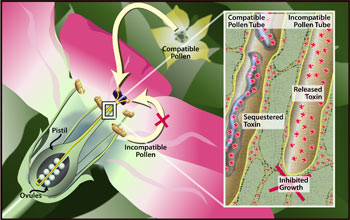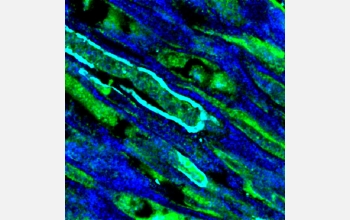All Images
News Release 06-033
New Clues in the Plant Mating Mystery
Researchers discover molecular details for maintenance of genetic fitness
This material is available primarily for archival purposes. Telephone numbers or other contact information may be out of date; please see current contact information at media contacts.

In flowering plants, reproduction is initiated when the pollen (the male) reaches the pistil (the female). For successful fertilization, the pollen must germinate and form a tube that grows within the pistil in order to reach the ovule. As the pollen tube extends, molecular information is exchanged that determines the compatibility of the pollen and pistil, such as their degree of genetic relatedness. In some plants, a toxin called S-RNase poisons the pollen tube if the pollen and pistil are too closely related, thus preventing inbreeding. Recent studies by Bruce McClure suggest the toxin is sequestered until the compatibility decision is made.
Credit: Nicolle Rager Fuller, National Science Foundation
Download the high-resolution JPG version of the image. (391 KB)
Use your mouse to right-click (Mac users may need to Ctrl-click) the link above and choose the option that will save the file or target to your computer.

This photomicrogaph shows a pollen tube (light blue) growing through the cells of a pistil. A toxin, S-RNase (dark blue), poisons the pollen to prevent plant inbreeding when necessary.
Credit: Ariel Goldraij, Mayandi Sivaguru, and Bruce McClure, University of Missouri-Columbia
Download the high-resolution JPG version of the image. (124 KB)
Use your mouse to right-click (Mac users may need to Ctrl-click) the link above and choose the option that will save the file or target to your computer.


